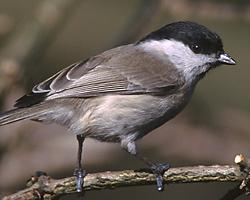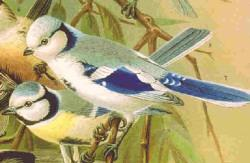
Poids et mesures
| Longueur | 11,5 cm |
|---|---|
| Poids | 11 g |
Statut de conservation
| Intrépide |
Description de l'animal
The Willow Tit, scientifically named Poecile montanus, is a captivating small passerine bird that belongs to the tit family, Paridae. It is a species that garners attention not only for its charming appearance but also for its intriguing behaviors and habitat preferences. This bird is primarily found across the temperate regions of Europe and Asia, showcasing a remarkable adaptability to various environments.Characterized by its modest size, the Willow Tit typically measures about 11.5 to 12.5 cm in length, with a wingspan ranging from 17 to 19.5 cm. The bird's weight varies between 8 to 13 grams, making it a lightweight, agile creature. Its plumage is predominantly a mixture of black, white, and grey hues, which provides it with excellent camouflage against the bark of trees and the forest underbrush. One of the most distinctive features of the Willow Tit is its black cap and bib, which contrast strikingly with its white cheeks and pale underparts. The bird's back is a subtle shade of grey or brown, which blends seamlessly into its natural surroundings.
The Willow Tit is known for its preference for boggy woodlands, often with a significant presence of willow, birch, and alder trees. It is also found in coniferous forests and shrubby areas, demonstrating its adaptability to different forested environments. This bird is largely resident in its range, although some populations in the northernmost parts of its distribution may migrate short distances southward during the winter.
One of the most fascinating aspects of the Willow Tit's behavior is its nesting habits. Unlike many other tit species that nest in pre-existing cavities, the Willow Tit often excavates its own nesting hole. This behavior showcases the bird's industrious nature, as it uses its bill to carve out cavities primarily in decaying wood, creating a safe haven for its eggs and chicks. This process can take the bird several weeks, underscoring its dedication to preparing a secure nesting site.
The diet of the Willow Tit primarily consists of insects, spiders, and other small invertebrates during the breeding season, making it an essential part of the ecosystem in controlling insect populations. In the winter, its diet shifts to include seeds and berries, allowing it to survive the colder months when insects are less abundant.
Vocally, the Willow Tit is known for its distinctive "zee-zee-zee" call, which is often a reliable indicator of its presence in an area. Its song, a series of high-pitched notes, is less often heard but is equally enchanting, adding to the auditory landscape of its habitat.
Conservation efforts for the Willow Tit are increasingly important as habitat loss and degradation pose significant threats to its populations. In some parts of its range, the species has experienced declines, making conservation initiatives critical to ensuring its survival. Protecting the habitats that the Willow Tit depends on, along with promoting practices that support biodiversity, are essential steps in conserving this delightful bird for future generations to enjoy.
In summary, the Willow Tit is a small yet fascinating bird that captures the hearts of birdwatchers and nature enthusiasts alike. Its adaptability, intriguing behaviors, and the critical role it plays in its ecosystem make it a species of significant interest and importance in the avian world.
Animaux similaires
Nouvelles photos d'animaux
Top 10 des animaux
- Dolphin gull (Leucophaeus scoresbii)
- Diana monkey (Cercopithecus diana)
- Moustached guenon (Cercopithecus cephus)
- Galápagos tortoise (Geochelone nigra complex)
- Russian tortoise (Testudo horsfieldii)
- Stone loach (Barbatula barbatula)
- Japanese macaque (Macaca fuscata)
- Greek tortoise (Testudo graeca)
- Common flying dragon (Draco volans)
- Vendace (Coregonus albula)


